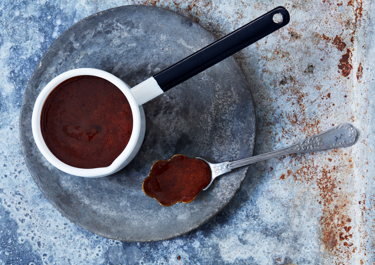Teriyaki sauce

Our homemade teriyaki sauce recipe draws you into a world of flavour. It combines the warm spice of ginger, velvety honey, rich brown sugar, complex umami from tamari soy, subtly sweet mirin, and aromatic sesame oil. The ingredients combine easily, resulting in a sauce that is as textured as it is tasteful.
Ingredients
|
Fresh ginger
|
50 g |
|---|---|
|
Garlic cloves
|
2 |
|
Brown sugar
|
100 ml |
|
Tamari soya sauce
|
150 ml |
|
Water
|
100 ml |
|
Mirin
|
3 tbsp |
|
Honey
|
1 tbsp |
|
Sesame oil
|
1 tbsp |
|
Corn flour
|
1 tbsp |
Instructions
FAQ: Questions about teriyaki sauce
Do you want to know more about this flavourful sauce? Then, keep reading below, where we will answer some of the common questions asked about it.
How can I use teriyaki sauce?
Teriyaki sauce works well for many dishes. It is ideal as a marinade for chicken, beef, and pork, or a glaze for grilled vegetables and seafood. You can also add it to stir-fries or serve it as a dipping sauce for appetisers. For a quick meal, toss the sauce with noodles or drizzle over rice bowls topped with vegetables and meat, tofu, or other types of protein. Even sandwiches and wraps can benefit from a hint of teriyaki, adding an Asian flair to your everyday lunches.
How long can I store homemade teriyaki sauce?
Keep homemade teriyaki sauce in a sealed container in the fridge. It will stay fresh for up to 2 weeks. You can also freeze it for up to 3 months. This way, you can make bigger batches and always have some at hand for quick meals and delightful dips.
What is the difference between teriyaki marinade and sauce?
Teriyaki marinade and sauce have similar ingredients but are used differently. The marinade is a thinner liquid for flavouring food before cooking. Teriyaki sauce is thicker, often with cornflour added, and is used as a glaze or topping to boost the taste and look of your dish.
Tips: Making the best teriyaki sauce
With its sweet and umami flavours, teriyaki sauce is suitable for several delicious dishes. Read below for some of our best tips to get the best result!
Alternative ingredients for mirin
If you do not have mirin, you can still make a tasty teriyaki sauce. Mix some sherry or sweet white wine with a bit of sugar to capture mirin’s sweet and deep flavour. You can also make an alcohol-free alternative by mixing apple cider vinegar and sugar or rice vinegar and sugar.
Meal-prep and store it properly
Make a large batch of teriyaki sauce to save time when you need it. Let it cool completely, then transfer it to an airtight glass or plastic container. Refrigerate for up to 2 weeks to keep it fresh. For longer storage, freeze the sauce in an ice cube tray and then store the cubes in a freezer bag for up to 3 months. This ensures you have delicious teriyaki sauce on hand whenever you need it.
Balancing flavours
While the honey and brown sugar add a lovely depth and sweetness, make sure to taste as you go and adjust according to your preference. If it is too sweet, you can balance it out with a little more tamari soy or a splash of rice vinegar for some acidity.
Prepare a homemade teriyaki sauce
Do your meals a big favour and make this delicious teriyaki sauce. With a glossy finish and rich flavours, it is the perfect condiment for noodles, rice, vegetables, meat, and much more. Teriyaki is a gem of Japanese cuisine and is a must-have in any kitchen, letting you flavour quick dishes and fancy sides with just one simple sauce.
Perfect mix of sweet, savoury, and umami flavours
Bring a touch of elegance to any dish with our teriyaki recipe. The classic ingredients from Japanese cuisine create a base that has a little bit of everything from sweet honey and brown sugar to savoury soy sauce and tangy mirin. This blend allows the natural sweetness to caramelise during cooking, while the umami from soy deepens the flavour. Subtle hints of ginger add a spicy kick, elevating the overall taste and making this sauce a perfect complement to a wide array of dishes.
What is teriyaki sauce?
Teriyaki sauce is derived from the Japanese words “teri,” meaning shine, and “yaki,” which refers to grilling. It is often used for marinating and glazing meats and vegetables and as a dipping sauce. It is popular in various Asian-inspired dishes as well as for barbecuing. Traditionally, this sauce was a simple blend of soy sauce, sake or mirin, and sugar, used primarily as a light marinade and glaze for grilled fish. Today, however, the version we know best has undergone a significant transformation. It was adapted by Japanese immigrants in America to appeal to local palates, adding, for example, ginger and brown sugar, resulting in a thicker and sweeter sauce like the texture in our recipe.
Discover the many uses for teriyaki sauce
Picture succulent salmon marinated in teriyaki and then grilled to a perfect glaze. For a quick dinner and a delicious weeknight meal, stir-fry your favourite vegetables with slices of chicken or beef in teriyaki sauce and serve over steamed rice or noodles.
Use it for your next barbecue night, marinating beef, onion, and sweet pepper skewers in teriyaki. You can also prepare teriyaki-glazed tofu, baked or pan-fried until crispy, adding a flavourful punch to salads or stir-fries.
For a creative twist, use teriyaki sauce on homemade pizza, replacing traditional tomato sauce with teriyaki and topping with mozzarella, chicken, and red onions. Or transform classic burgers by mixing teriyaki sauce into the patties.
Check out some of our recipes from Asian cuisine: maki sushi with salmon, tuna, or turbot, nigiri with fish or avocado, or Vietnamese pho.
Add your own touch
Consider adding lemon or orange zest to introduce a bright, citrusy note that pairs well with the sweetness of the brown sugar and honey. If you enjoy a bit of heat, a pinch of crushed red pepper flakes or a small amount of finely chopped chilli pepper would add a warm, spicy layer that balances the sweetness.
You can also infuse the sauce with fresh garlic or fresh herbs like thyme or rosemary as it simmers to bring in subtle herbal notes. This will be delicious with meats like chicken or pork. Adding a splash of rice vinegar or apple cider vinegar can introduce a tangy contrast to the sweet ingredients. For a fruity touch, replace some of the water with fruit juices such as pineapple or apple juice. It adds extra flavour and helps the sauce caramelise better.








